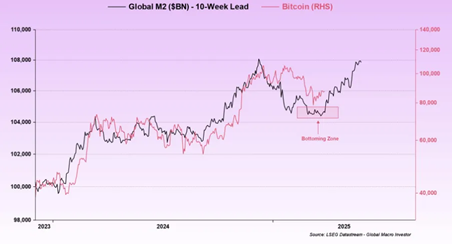Arthur Hayes: Bitcoin Could Hit $250,000 If Fed Returns to Quantitative Easing

Arthur Hayes – former CEO of crypto derivatives exchange BitMEX – has just made a striking prediction that Bitcoin (BTC) could skyrocket to $250,000 by the end of 2025, if the US Federal Reserve (Fed) shifts its policy to Quantitative Easing (QE).
Bitcoin $250,000 Scenario: It Depends on the Fed
In a recent market analysis blog, Hayes argues that the end of quantitative tightening (QT) and a return to liquidity injections would be a powerful catalyst for the cryptocurrency market, especially Bitcoin.
“If my analysis of the interaction between the Fed, Treasury, and banking system is correct, Bitcoin’s recent low of $76,500 is a stepping stone to $250,000 by the end of the year,” Hayes wrote.
He believes that mounting fiscal pressures will force the Fed to act to ensure the US Treasury can fund itself at reasonable interest rates. At that point, a halt to QE and a resumption of QE are almost inevitable.
“Powell showed last week that fiscal dominance is intact. He will do whatever it takes to make it possible for the Treasury to borrow money efficiently. I believe QE — at least in the Treasury — will have to stop in the short to medium term.”
Hayes believes that once QE is officially restarted, Bitcoin will “scream” with an unprecedented rally.
Raoul Pal and the Signal from the Global M2 Index
Supporting Hayes’s assessment, Raoul Pal – former CEO at Goldman Sachs – also emphasized the potential for a strong recovery for Bitcoin in the coming time.
He shared a chart of the correlation between the global M2 money supply and the Bitcoin price. According to the analysis, Bitcoin tends to increase after about 10 weeks since the global M2 begins to expand.

“The waiting game is almost over… 10 weeks of lead is what I am watching,” Pal wrote on social network X.
QCP Capital warns of “stagflation” scenario
However, not everyone is absolutely optimistic. Analysts at QCP Capital warned that if stagflation occurs, the Fed may not cut interest rates as expected, but even increase them.
“The Fed is stuck in a tight corner. Weak consumer confidence and data could signal a weaker Q2 GDP. Meanwhile, inflationary pressures from tariffs starting April 2 could start to bite,” QCP said.
While the market is still pricing in 2.5 rate cuts by 2025, a stagflation scenario could delay or reverse those expectations – thus weighing on Bitcoin’s bullish outlook.
Recovery momentum builds despite a dismal Q1
Despite Bitcoin’s worst first quarter in seven years, market analysts say selling pressure has waned and buyers are accepting the current price range – creating a potential accumulation zone in April and May.
“Sellers are exhausted. Buyers seem quite comfortable. This could be a quiet period before the market explodes,” said analyst Axel Adler Jr.
Additionally, veteran investors are also actively increasing their BTC holdings, which is often seen before major bull cycles. Market data shows that selling pressure is waning, opening the door for Bitcoin to reach $90,000 in the medium term.

Gold excels as a “safe haven”?
While Bitcoin is expected to be a macroeconomic asset during times of uncertainty, gold is emerging as an alternative store of value, especially as Trump’s tariff policies create new economic volatility.
A report from Standard Chartered asserts that Bitcoin is increasingly taking on the role of an inflation hedge, but gold’s strong comeback is creating new competitive pressure in the safe-haven asset category.
With a host of macroeconomic factors at play – from Fed policy to geopolitical developments and global money flows – Bitcoin is at a turning point. Is $250,000 a pipe dream, or just a matter of time?
If you want, I can write a shortened version or create a chart illustration (like BTC price, M2 correlation) for this post. Would you like?
